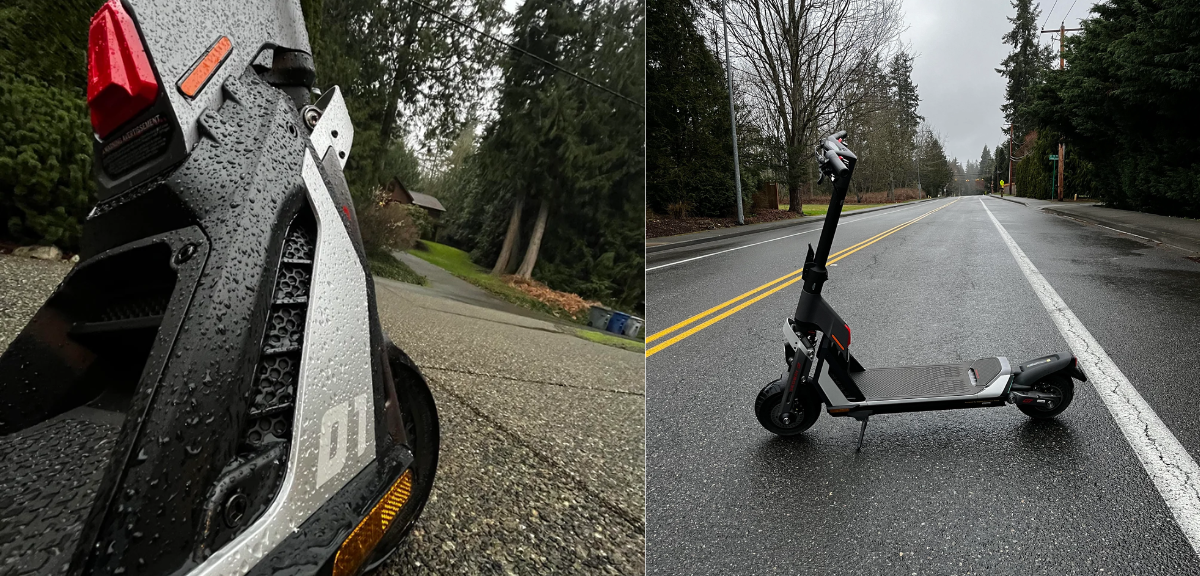When it comes to riding an electric scooter in the rain, things get trickier and potentially dangerous.
Although many riders may feel confident and experienced enough to take on wet conditions, it’s essential to understand why this is not advisable.
Riding an electric scooter in the rain presents several challenges that can affect your safety and the performance of the scooter.
Reasons Why You Should Avoid Riding An E-Scooter In The Rain Regardless Of The IP Rating
Water Damage to Electrical Components
Electric scooters rely heavily on electrical components, including the battery, motor, and wiring systems.
Exposure to water can pose a significant threat to these components. Most electric scooters have a certain level of water resistance, usually indicated by an IP (Ingress Protection) rating.
However, water resistance is not the same as being waterproof. Continuous exposure to rain can cause water to seep into critical areas, leading to short circuits or other electrical failures.
Damage to the battery is particularly concerning, as it is one of the most expensive components to replace.
Water exposure can lead to battery malfunctions, reducing the scooter’s range and potentially causing it to shut down unexpectedly during a ride.
Additionally, corrosion of electrical connectors can occur over time, leading to persistent issues even after the rain has stopped.
Slippery Surfaces and Reduced Traction
One of the most immediate concerns when riding an electric scooter in the rain is the loss of traction.
Wet surfaces significantly reduce the grip that scooter tires have on the road. This is especially true for slick surfaces such as painted road lines, metal grates, and leaves, which become extremely slippery when wet.
The risk of skidding and losing control of the scooter increases exponentially in these conditions. Unlike cars or motorcycles, electric scooters have smaller wheels, which can make it even harder to maintain traction on wet surfaces.
Additionally, most electric scooters are equipped with tires that are not designed for wet conditions.
These tires have shallower treads compared to those on bicycles or motorcycles, which means they cannot effectively channel water away from the contact patch.
As a result, riding through puddles or on wet roads increases the chances of hydroplaning, where the tires lose contact with the ground, making it nearly impossible to steer or brake effectively.
Compromised Braking Performance
Braking performance is another critical factor affected by rainy weather. Electric scooters typically use hydraulic, mechanical, or electronic braking systems, all of which can suffer in wet conditions.
Water can interfere with brake pads, discs, or drums, reducing their effectiveness. This can lead to longer stopping distances, which can be dangerous when sudden stops are needed to avoid obstacles or pedestrians.
Moreover, wet conditions can lead to a delayed response from brakes. In emergencies, the milliseconds it takes for brakes to engage fully can be the difference between a near miss and a serious accident.
The risk is further compounded by the reduced traction of wet surfaces, making it harder to stop quickly without skidding or sliding.
Reduced Visibility for Riders and Drivers
Rain doesn’t only affect the scooter itself; it also impacts the rider and other road users. Visibility is significantly reduced during rainfall, making it harder for riders to see obstacles, road signs, and other vehicles.
Wet conditions often lead to fogged-up visors or goggles, further hindering vision. The decreased visibility makes it challenging to anticipate and react to sudden changes in traffic or road conditions.
Other road users, such as drivers, also experience reduced visibility in the rain. This can make it harder for them to see scooter riders, increasing the risk of accidents.
Many drivers may not expect scooters on the road during adverse weather conditions, making sudden maneuvers or lane changes more likely to result in collisions.
Hypothermia and Rider Discomfort
Rainy weather often brings cooler temperatures, which can lead to rider discomfort and, in severe cases, hypothermia.
Riding an electric scooter in such conditions exposes the rider to wind and rain, making it difficult to stay warm and dry. Prolonged exposure to cold and wet conditions can quickly lead to chills and discomfort, affecting a rider’s concentration and reaction time.
While protective clothing such as waterproof jackets and pants can help mitigate some of these effects, they are not foolproof.
Rain can still find its way through gaps in clothing, leading to soaked attire and reduced body warmth. Cold hands, in particular, can impact a rider’s ability to control the scooter effectively, as numb fingers make it difficult to grip the handlebars or operate controls.
Conclusion
Riding an electric scooter in the rain is fraught with risks and challenges that can compromise your safety and the scooter’s performance.
From reduced traction and braking efficiency to potential water damage and legal implications, the dangers are significant.
While it may be tempting to brave the elements for convenience, it is often wiser to seek alternative transportation or wait until conditions improve.
By prioritizing safety and understanding the risks, you can ensure a safer and more enjoyable riding experience.
